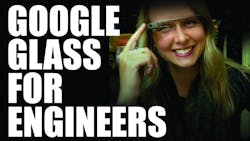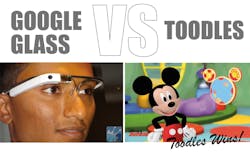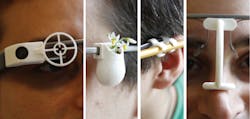On a recent trip to Chicago for PowderMet 2013 and TechWeek, I took a break to meet up with my good friend Brad Kleinman. Upon meeting, Brad placed a flimsy pouch on the table and gestured to open it. I carefully took out, in awe and wonder, what was said to be one of forty sets of Google Glass available in the Windy City.
Minutes after I put them on, the sound from the restaurant turned from boisterous to faint. Yep, Brad and I were finally the cool kids.
During the test drive I read webpages, took pictures and video, navigated with a map, and listened to emails via the bone conduction transducer. My personal opinion? Meh, I could live without Glass.
While I'm a fan of having information at my fingertips, I'm not so sure about information at my eyeballs. It felt like a cell phone was awkwardly close to my head. I'm also not a fan of half-baked ideas, so if a device is going to be that close to my cornea, it might as well be on it. So I'll wait for the arrival of these soft contact lenses that could one day display information.
I was also disappointed to learn Google doesn't offer insurance on these techno shades, especially because this generation of product is basically for field testing and claiming the space.
Regardless, I wanted to figure out how this tool could help engineers right now. Luckily Brad, who is now an accomplished digital strategist, is still able to dig into his previous life as an mechanical engineer. So we put our MechE brains together and came up with a few ideas.
DOCUMENTING: Hands-free and voice-activated Google Glass lets you take pictures, shoot video, and broadcast live without interruption. These features can help document product testing, create instructions for assembly/disassembly, and catch your coworker stealing supplies from your desk.
3D MODELING: If enough images are taken around a subject, they can be converted into a 3D model via a software program. We saw this at the RAPID show this year at The Shape Shot system booth. Shape Shot uses four off-the-shelf digital cameras to take images instantaneously. These images are then combined to create a 3D model of a subject.
TROUBLESHOOTING: With Glass you can watch a video, pull up images, read websites, and view 3D models (but don't download too many assemblies because Glass only has 16 GB space). These features are especially helpful for field work. For example, an engineer working on an aircraft engine can use Glass to broadcast live video to a team thousands of miles away.
RESEARCHING: Voice prompts can help a CAD modeler access Google to quickly search for a standard, an equation, or more specific material properties. Note: I recommend standing still or sitting while reading Google Glass, otherwise research could get dangerous.
IMPROVING: You're an engineer. Make it better.
If you could incorporate any feature, what would you add?
If you could design an app for Google Glass, what would it do? 3D scan, FEA, measure heat?
Glass Tesla is an example of an app that uses Google Glass to manage functions in Elon Musk's Tesla Model S electric car, such as navigation and climate controls.
Would you make Glass look different?
Todd Blatt in Brooklyn, NY started a line of 3D printed accessories for Google Glass. I personally like the 'Optigrab' seen on the right for those of you familiar with the Steve Martin comedy, The Jerk.
About the Author
Lindsey Frick Blog
Associate Editor
Lindsey serves a Associate Editor for Machine Design since 2012. She holds a Bachelor of Science in mechanical engineering from Cleveland State University. Prior to joining Penton, she has worked in product design, packaging, development, strategy, and manufacturing. She covers the materials market and other areas of interest for design engineers.



